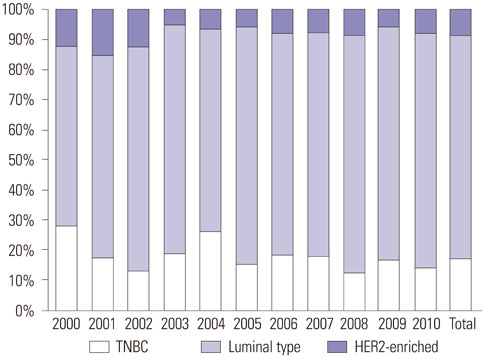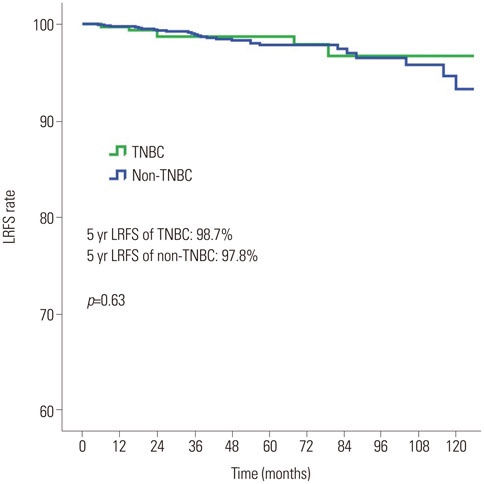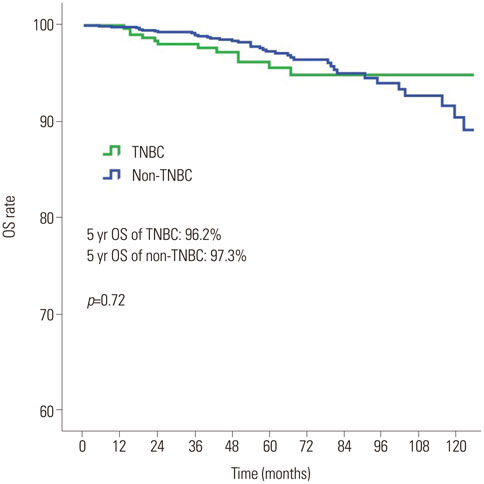Yonsei Med J.
2016 Sep;57(5):1192-1198. 10.3349/ymj.2016.57.5.1192.
Comparisons of Oncologic Outcomes between Triple-Negative Breast Cancer (TNBC) and Non-TNBC among Patients Treated with Breast-Conserving Therapy
- Affiliations
-
- 1Department of Surgery, Yonsei University College of Medicine, Seoul, Korea. skim@yuhs.ac
- KMID: 2374165
- DOI: http://doi.org/10.3349/ymj.2016.57.5.1192
Abstract
- PURPOSE
The optimum local surgical strategy regarding breast-conserving therapy (BCT) for triple-negative breast cancer (TNBC) is controversial. To investigate whether BCT is appropriate for patients with TNBC, we evaluated the clinical outcomes of BCT in women with TNBC compared to those of women without TNBC, using a large, single-center cohort.
MATERIALS AND METHODS
We performed a retrospective analysis of 1533 women (TNBC n=321; non-TNBC n=1212) who underwent BCT for primary breast cancer between 2000 and 2010. Clinicopathological characteristics, locoregional recurrence-free survival (LRFS), and overall survival (OS) were analyzed.
RESULTS
Tumors from the TNBC group had a higher T stage (T2 37.4% vs. 21.0%, p<0.001), a lower N stage (N0 86.9% vs. 75.5%, p<0.001), and a higher histologic grade (Grade III 66.8% vs. 15.4%, p<0.001) than the non-TNBC group. There were no differences in 5-year LRFS rates between the TNBC and non-TNBC groups (98.7% vs. 97.8%, p=0.63). The non-TNBC group showed a slightly better 5-year OS than the TNBC group; however, the difference was not significant (96.2% vs. 97.3%, p=0.72). In multivariate analyses, TNBC was not associated with poor clinical outcomes in terms of LRFS and OS [hazard ratio (HR) for LRFS=0.37, 95% confidence interval (CI): 0.10-1.31; HR for OS=1.03, 95% CI: 0.31-3.39].
CONCLUSION
TNBC patients who underwent BCT showed non-inferior locoregional recurrence compared to non-TNBC patients with BCT. Thus, BCT is an acceptable surgical approach in patients with TNBC.
MeSH Terms
-
Adult
Aged
Breast Neoplasms/mortality/pathology/*surgery
Disease-Free Survival
Female
Humans
*Mastectomy, Segmental
Middle Aged
*Neoplasm Recurrence, Local/mortality/pathology
Proportional Hazards Models
Retrospective Studies
Time Factors
Treatment Outcome
Triple Negative Breast Neoplasms/mortality/pathology/*surgery
Figure
Cited by 1 articles
-
Image Analysis of HER2 Immunohistochemical Staining of Surgical Breast Cancer Specimens
Kwangil Yim, Hong Sik Park, Dong Min Kim, Youn Soo Lee, Ahwon Lee
Yonsei Med J. 2019;60(2):158-162. doi: 10.3349/ymj.2019.60.2.158.
Reference
-
1. Kim Z, Min SY, Yoon CS, Lee HJ, Lee JS, Youn HJ, et al. The basic facts of korean breast cancer in 2011: results of a nationwide survey and breast cancer registry database. J Breast Cancer. 2014; 17:99–106.
Article2. Veronesi U, Cascinelli N, Mariani L, Greco M, Saccozzi R, Luini A, et al. Twenty-year follow-up of a randomized study comparing breast-conserving surgery with radical mastectomy for early breast cancer. N Engl J Med. 2002; 347:1227–1232.
Article3. van Dongen JA, Voogd AC, Fentiman IS, Legrand C, Sylvester RJ, Tong D, et al. Long-term results of a randomized trial comparing breast-conserving therapy with mastectomy: European Organization for Research and Treatment of Cancer 10801 trial. J Natl Cancer Inst. 2000; 92:1143–1150.
Article4. Poggi MM, Danforth DN, Sciuto LC, Smith SL, Steinberg SM, Liewehr DJ, et al. Eighteen-year results in the treatment of early breast carcinoma with mastectomy versus breast conservation therapy: the National Cancer Institute Randomized Trial. Cancer. 2003; 98:697–702.
Article5. Fisher B, Anderson S, Bryant J, Margolese RG, Deutsch M, Fisher ER, et al. Twenty-year follow-up of a randomized trial comparing total mastectomy, lumpectomy, and lumpectomy plus irradiation for the treatment of invasive breast cancer. N Engl J Med. 2002; 347:1233–1241.
Article6. NIH consensus conference. Treatment of early-stage breast cancer. JAMA. 1991; 265:391–395.7. Perou CM, Sørlie T, Eisen MB, van de Rijn M, Jeffrey SS, Rees CA, et al. Molecular portraits of human breast tumours. Nature. 2000; 406:747–752.
Article8. Ahn SG, Lee HM, Lee SA, Jeong J, Lee HD. Long-term survival analysis of korean breast cancer patients at a single center: improving outcome over time. Yonsei Med J. 2014; 55:1187–1195.
Article9. Brenton JD, Carey LA, Ahmed AA, Caldas C. Molecular classification and molecular forecasting of breast cancer: ready for clinical application? J Clin Oncol. 2005; 23:7350–7360.
Article10. Tang P, Skinner KA, Hicks DG. Molecular classification of breast carcinomas by immunohistochemical analysis: are we ready? Diagn Mol Pathol. 2009; 18:125–132.
Article11. Carey LA, Perou CM, Livasy CA, Dressler LG, Cowan D, Conway K, et al. Race, breast cancer subtypes, and survival in the Carolina Breast Cancer Study. JAMA. 2006; 295:2492–2502.
Article12. Park S, Koo JS, Kim MS, Park HS, Lee JS, Lee JS, et al. Characteristics and outcomes according to molecular subtypes of breast cancer as classified by a panel of four biomarkers using immunohistochemistry. Breast. 2012; 21:50–57.
Article13. Voduc KD, Cheang MC, Tyldesley S, Gelmon K, Nielsen TO, Kennecke H. Breast cancer subtypes and the risk of local and regional relapse. J Clin Oncol. 2010; 28:1684–1691.
Article14. Chen X, Yu X, Chen J, Zhang Z, Tuan J, Shao Z, et al. Analysis in early stage triple-negative breast cancer treated with mastectomy without adjuvant radiotherapy: patterns of failure and prognostic factors. Cancer. 2013; 119:2366–2374.
Article15. Dent R, Trudeau M, Pritchard KI, Hanna WM, Kahn HK, Sawka CA, et al. Triple-negative breast cancer: clinical features and patterns of recurrence. Clin Cancer Res. 2007; 13(15 Pt 1):4429–4434.
Article16. Harissis HV, Ziogas D, Baltogiannis G. Mastectomy vs breast-conserving surgery: an old dilemma comes again for early breast cancer. Ann Surg Oncol. 2010; 17:1966–1967.
Article17. Kreike B, Halfwerk H, Armstrong N, Bult P, Foekens JA, Veltkamp SC, et al. Local recurrence after breast-conserving therapy in relation to gene expression patterns in a large series of patients. Clin Cancer Res. 2009; 15:4181–4190.
Article18. Zaky SS, Lund M, May KA, Godette KD, Beitler JJ, Holmes LR, et al. The negative effect of triple-negative breast cancer on outcome after breast-conserving therapy. Ann Surg Oncol. 2011; 18:2858–2865.
Article19. Nguyen PL, Taghian AG, Katz MS, Niemierko A, Abi Raad RF, Boon WL, et al. Breast cancer subtype approximated by estrogen receptor, progesterone receptor, and HER-2 is associated with local and distant recurrence after breast-conserving therapy. J Clin Oncol. 2008; 26:2373–2378.
Article20. Wang J, Xie X, Wang X, Tang J, Pan Q, Zhang Y, et al. Locoregional and distant recurrences after breast conserving therapy in patients with triple-negative breast cancer: a meta-analysis. Surg Oncol. 2013; 22:247–255.
Article21. Zumsteg ZS, Morrow M, Arnold B, Zheng J, Zhang Z, Robson M, et al. Breast-conserving therapy achieves locoregional outcomes comparable to mastectomy in women with T1-2N0 triple-negative breast cancer. Ann Surg Oncol. 2013; 20:3469–3476.
Article22. Bhatti AB, Khan AI, Siddiqui N, Muzaffar N, Syed AA, Shah MA, et al. Outcomes of triple-negative versus non-triple-negative breast cancers managed with breast-conserving therapy. Asian Pac J Cancer Prev. 2014; 15:2577–2581.
Article23. Gangi A, Chung A, Mirocha J, Liou DZ, Leong T, Giuliano AE. Breast-conserving therapy for triple-negative breast cancer. JAMA Surg. 2014; 149:252–258.
Article24. Abdulkarim BS, Cuartero J, Hanson J, Deschênes J, Lesniak D, Sabri S. Increased risk of locoregional recurrence for women with T1-2N0 triple-negative breast cancer treated with modified radical mastectomy without adjuvant radiation therapy compared with breast-conserving therapy. J Clin Oncol. 2011; 29:2852–2858.
Article25. Haffty BG, Yang Q, Reiss M, Kearney T, Higgins SA, Weidhaas J, et al. Locoregional relapse and distant metastasis in conservatively managed triple negative early-stage breast cancer. J Clin Oncol. 2006; 24:5652–5657.
Article26. Cho JH, Park JM, Park HS, Park S, Kim SI, Park BW. Oncologic safety of breast-conserving surgery compared to mastectomy in patients receiving neoadjuvant chemotherapy for locally advanced breast cancer. J Surg Oncol. 2013; 108:531–536.
Article27. Singletary SE, Connolly JL. Breast cancer staging: working with the sixth edition of the AJCC Cancer Staging Manual. CA Cancer J Clin. 2006; 56:37–47.
Article28. Boyle P. Triple-negative breast cancer: epidemiological considerations and recommendations. Ann Oncol. 2012; 23:Suppl 6. vi7–v12.
Article29. Bauer KR, Brown M, Cress RD, Parise CA, Caggiano V. Descriptive analysis of estrogen receptor (ER)-negative, progesterone receptor (PR)-negative, and HER2-negative invasive breast cancer, the so-called triple-negative phenotype: a population-based study from the California cancer Registry. Cancer. 2007; 109:1721–1728.
Article30. Ismail-Khan R, Bui MM. A review of triple-negative breast cancer. Cancer Control. 2010; 17:173–176.
Article31. Arvold ND, Taghian AG, Niemierko A, Abi Raad RF, Sreedhara M, Nguyen PL, et al. Age, breast cancer subtype approximation, and local recurrence after breast-conserving therapy. J Clin Oncol. 2011; 29:3885–3891.
Article32. Yi M, Huo L, Koenig KB, Mittendorf EA, Meric-Bernstam F, Kuerer HM, et al. Which threshold for ER positivity? a retrospective study based on 9639 patients. Ann Oncol. 2014; 25:1004–1011.
Article33. Hammond ME, Hayes DF, Dowsett M, Allred DC, Hagerty KL, Badve S, et al. American Society of Clinical Oncology/College Of American Pathologists guideline recommendations for immunohistochemical testing of estrogen and progesterone receptors in breast cancer. J Clin Oncol. 2010; 28:2784–2795.
Article34. Moran MS. Should triple-negative breast cancer (TNBC) subtype affect local-regional therapy decision making? Am Soc Clin Oncol Educ Book. 2014; e32–e36.
Article
- Full Text Links
- Actions
-
Cited
- CITED
-
- Close
- Share
- Similar articles
-
- Molecular Classification of Triple-Negative Breast Cancer
- Differences in prognosis by p53 expression after neoadjuvant chemotherapy in triple-negative breast cancer
- LncRNA DLG1-AS1 Promotes Cancer Cell Proliferation in Triple Negative Breast Cancer by Downregulating miR-203
- Bilateral Triple-Negative Invasive Breast Cancer with a BRCA2 Mutation, and Glioblastoma: A Case Report and Literature Review
- Durable Response of Androgen Receptor-Positive Male Breast Cancer to Goserelin




